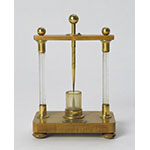Apparatus used to pierce strips of paper, or even thin glass, by means of the electrical charge between two point electrodes. Jean-Antoine Nollet devised this experiment c. 1740, in an attempt to prove his theory of two electric fluids by the appearance of the holes punctured by the discharge in the paper. The two fluids were known as "effluent" and "affluent"—which, in the science of electricity, respectively denote an electric fluid flowing into and out of a body. The instrument, described by Nollet in Essai sur l'électricité des corps (Paris, 1750), was used for teaching purposes until the early twentieth century to illustrate the mechanical effects of the electrical discharge. Provenance: Lorraine collections.
Provenance
Inventors
Context
Dictionary
In depth










